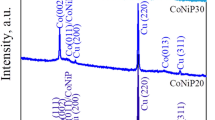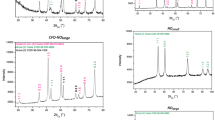Abstract
WITH the advent of high-temperature superconductivity, the search is on for applications of these materials. Here we outline a new method for the separation of paramagnetic and diamagnetic molecules using the repulsive interaction between a magnetic dipole and a micro-cavity in a ceramic material which is in the superconducting state. We present experiments of the permeation of air through YBa2Cu3O7−δ and through Bi1.8Pb0.2Ca2Sr2Cu3Ox ceramic pellets. These experiments show the preferential permeability of nitrogen compared with that of oxygen in the diamagnetic state of the superconductors below the critical transition temperature, Tc. This effect is quenched by the application of a large enough external magnetic field. As far as we know it is the first application of the porosity of the ceramic superconductors.
This is a preview of subscription content, access via your institution
Access options
Subscribe to this journal
Receive 51 print issues and online access
$199.00 per year
only $3.90 per issue
Buy this article
- Purchase on Springer Link
- Instant access to full article PDF
Prices may be subject to local taxes which are calculated during checkout
Similar content being viewed by others
References
Reich, S. Am. J. Phys. 56, 1039 (1988).
CRC Handbook of Chemistry and Physics 64th edn, F-45. (CRC, Boca Raton, 1984).
Stoner, E. C. Magnetism and Atomic Structure (Methuen, London, 1926) 142 (Curie's corrected result is x=32 x 0.0307/ T).
Breck, D. W. Zeolite Molecular Sieves 636, 650 (Wiley New York, 1974).
Breck, D. W. Zeolite Molecular Sieves 638 (Wiley, New York, 1974).
Cabasso, I. Encyclopedia of Polymer Science and Engineering Vol. 9, 2nd edn, 564 (Wiley, New York, 1987).
Experimental Cryophysics (eds Hoare, F. E., Jackson, L. C. & Kurti, N.) 42 (Butterworths, London, 1961).
Author information
Authors and Affiliations
Rights and permissions
About this article
Cite this article
Reich, S., Cabasso, I. Separation of paramagnetic and diamagnetic molecules using high-Tc superconducting ceramics. Nature 338, 330–332 (1989). https://doi.org/10.1038/338330a0
Received:
Accepted:
Issue Date:
DOI: https://doi.org/10.1038/338330a0
This article is cited by
-
A superconducting filter to separate an oxygen and argon mixture
Journal of Porous Materials (1995)
Comments
By submitting a comment you agree to abide by our Terms and Community Guidelines. If you find something abusive or that does not comply with our terms or guidelines please flag it as inappropriate.



